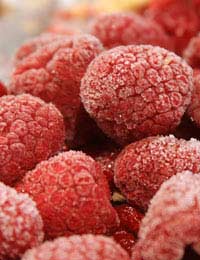
When you’ve grown your own fruit and vegetables, you’ll need to know a thing or two about storing them. There’s nothing worse than finding that your lovingly-grown parsnips have gone woody in the ground or that your precious apple crop has rotted before you got through it all. This is vital stuff for any vegetable grower. And if you’re aiming for full or partial self-sufficiency, understanding storage methods will give your crops an increased value. Here are our top tips for storing fruit and veg for longer.
Freezing Vegetables
If you are taking a self-sufficient approach, your freezer becomes – first and foremost – a place to store ready-chopped vegetables. Ready-meals and frozen chips have no place here; relegate sausages and ice trays to one drawer and dedicate the rest to your homegrown vegetables. French beans, runner beans and carrots – good summer crops – can be prepared and frozen in single-portion bags (not boxes, which take up more space). If you have space for an additional chest freezer in the garage or shed, even better.
Freezing Fruit
Raspberries, blueberries, cherries, redcurrants and blackcurrants will freeze nicely if you use the open-tray method. Arrange them on a baking sheet (pitting cherries first), so the berries are not touching, and pop into the freezer for a few hours. When they’re hard, tumble them into sandwich bags and return to the freezer – this technique keeps them from becoming a solid lump of berry mush. Strawberries don’t freeze very well in this way. Apples, plums and rhubarb are better cooked first and then frozen. Soften them with a little brown sugar then freeze and they’re ready to turn into crumbles or pies later in the year.
Storing Root Vegetables
Any root vegetables that you have not heeled in (see article on heeling in) can be stored in a cool, sheltered place like a shed, porch or garage. You will need old wooden boxes (the type that apples arrive at the grocer’s in – try asking around), newspaper, sand, and a place to stack them all. A chest-of-drawer type arrangement works well. Brush off the loose soil from your carrots, parsnips, turnips and swedes. Put a layer of newspaper in the bottom of a wooden box and add a layer of sand, then arrange the roots on top. Cover completely with sand and keep the vegetables cool. Check for signs of rot now and again.
Storing Onions and Garlic
The old idea of storing garlic hung from a plait in the kitchen is a nice thought, but it doesn’t work, the humidity and heat in a modern kitchen will cause the garlic to rot too quickly. The key to storing onions and garlic is to ensure that they have been thoroughly dried in the first place. Give them a couple of weeks laid out in the sun, bringing them in at night and during showers. When the skins are thickly papery, you can trim the stems and store the onions and garlic heads in string bags – again, choosing a cool, sheltered, shady place (a shed or garage is perfect).
